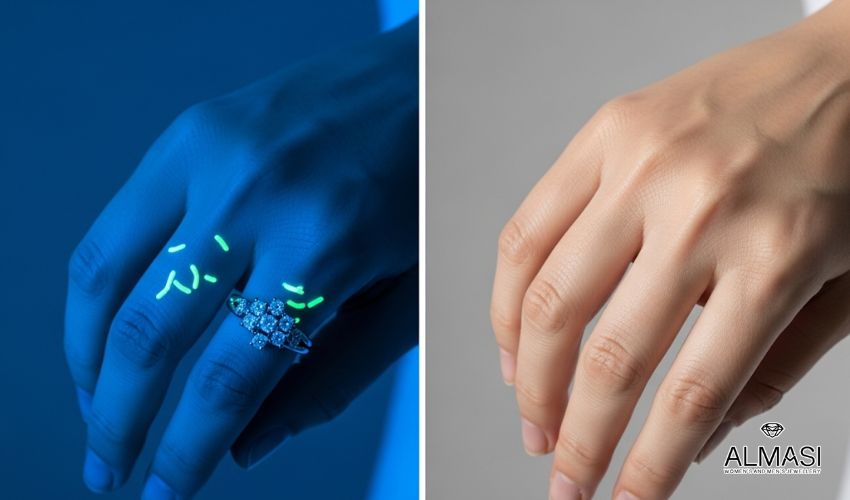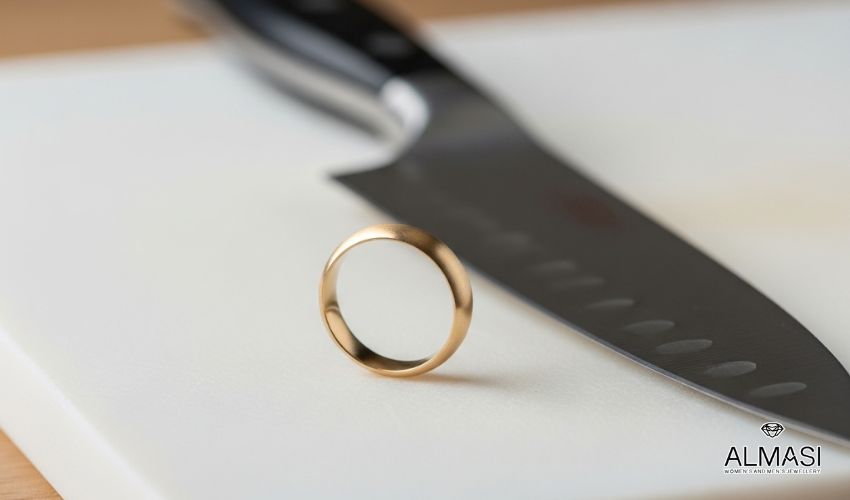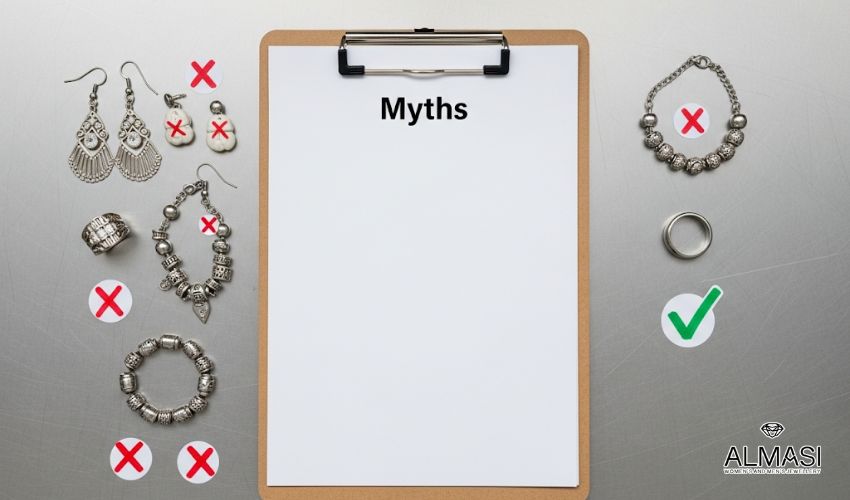Food safety regulations are clear: plain wedding bands represent the only jewelry allowed when preparing food. The FDA Food Code restricts all other jewelry on hands and arms to prevent contamination risks that could harm customers and violate health standards. Smart food handlers know that even simple accessories can create serious problems in commercial kitchens.
Why Food Safety Regulations Restrict Jewelry?
The FDA Food Code exists because jewelry creates real dangers in food preparation areas. Health inspectors see contamination incidents daily that trace back to improperly worn accessories. Jewelry traps bacteria in ways most people never consider.
Small crevices in rings collect food particles that become breeding grounds for harmful microorganisms. Watches and bracelets create similar problems by harboring germs that transfer directly to food during preparation.
Physical contamination presents another major risk. Loose stones, watch parts, or jewelry pieces can fall into food and create choking hazards. Restaurant insurance claims regularly include incidents where customers found jewelry fragments in their meals.
According to the FDA Food Code, contaminated hands cause 9 out of 10 food contamination incidents. Jewelry on hands and arms makes proper handwashing nearly impossible, creating conditions where dangerous pathogens survive and spread.
The Science Behind Contamination Risk

Bacterial growth patterns on jewelry reveal why food safety experts take such strict positions. Intricate jewelry designs create microenvironments where bacteria multiply rapidly. Ring settings with stones create particular problems. The spaces between metal and gems trap organic matter that becomes difficult to clean. Standard handwashing cannot remove bacteria from these hidden areas, meaning contamination persists even after seemingly thorough cleaning.
Metal types also matter for bacterial growth. Some materials harbor more bacteria than others, but even the safest metals become contaminated when they include decorative elements or complex designs. Temperature changes in kitchen environments cause jewelry to expand and contract. These movements create new spaces where bacteria can hide and multiply, making contamination control even more challenging.
What Jewelry Creates the Most Danger
Different jewelry types present varying levels of contamination risk. Understanding these differences helps food handlers make safer choices.
Highest Risk Jewelry
- Rings with stones or complex settings
- Watches with metal bands or moving parts
- Bracelets with charms or decorative elements
- Medical alert bracelets with information plates
Moderate Risk Jewelry
- Plain metal rings with smooth surfaces
- Simple stud earrings close to the ear
- Silicone rings without texture
Prohibited on Hands/Arms
- All watches and fitness trackers
- All bracelets including medical alert types
- All rings except plain wedding bands
Earrings and necklaces create different risks. The FDA Food Code technically allows them since they don’t contact food directly. However, many employers prohibit all jewelry to maintain consistent safety standards.
Plain Wedding Bands are the Safe Exception

Plain wedding bands earn FDA approval because they minimize contamination risks while respecting personal significance. These rings must meet specific criteria to qualify as safe. Approved Wedding Band Characteristics are:
- Smooth, continuous metal surface
- No stones, engravings, or decorative elements
- No gaps or crevices where bacteria can hide
- Easy to clean and sanitize
Wedding bands still require careful maintenance. Food handlers must wash hands thoroughly before and after food preparation, paying special attention to areas around the ring. Regular sanitizing prevents bacterial buildup that could contaminate food.
Some employers require gloves even with approved wedding bands. Double-gloving provides extra protection, especially when handling raw meat or other high-risk foods.
Alternative Solutions for Food Handlers
Food handlers who want to wear jewelry have several safe alternatives that don’t violate health codes.
- Silicone Rings: Silicone wedding bands offer practical benefits over traditional metal rings. They clean easily, resist bacterial growth, and break away if caught on equipment. Many food service professionals prefer silicone for its safety and durability.
- Jewelry Storage Systems: Professional kitchens often provide secure storage for personal jewelry. Food handlers can safely store valuable pieces during work hours and retrieve them afterward.
- Alternative Locations: Some jewelry can be worn safely in locations that don’t contact food. Ankle bracelets or jewelry worn under clothing may be acceptable, depending on workplace policies.
Common Misconceptions About Allowed Jewelry

Several misconceptions persist about jewelry allowances in food service. These misunderstandings can lead to health code violations and contamination incidents.
Myth: Expensive jewelry is safer than cheap jewelry.
Reality: Material cost has no bearing on contamination risk. Intricate expensive pieces often create more bacterial hiding spots than simple designs.
Myth: Gloves eliminate jewelry contamination risks.
Reality: Jewelry can tear gloves, creating contamination pathways. Bacteria can also transfer from jewelry to gloves during removal.
Myth: Medical alert bracelets are always allowed.
Reality: While the Americans with Disabilities Act requires reasonable accommodations, medical bracelets on wrists still pose contamination risks. Alternative solutions like ankle bracelets or necklaces work better.
Myth: Celebrity chefs wear jewelry, so it must be safe.
Reality: Television cooking shows don’t follow commercial food service regulations. Celebrity chefs often wear jewelry that would violate health codes in restaurants.
Enforcement and Penalties
Health inspectors actively enforce jewelry restrictions during routine inspections. Violations can result in serious consequences for food service establishments.
Common Violations
- Food handlers wearing watches or bracelets
- Rings with stones or decorative elements
- Unsecured medical alert jewelry
- Failure to remove jewelry during food preparation
Penalties: Health departments can issue citations, require corrective action, or temporarily close establishments for repeated violations. These penalties cost businesses money and damage reputations.
Inspector Focus Areas: Health inspectors pay special attention to jewelry compliance during peak service hours. They look for violations that might be hidden during slower periods.
Final Thoughts: The Hidden Costs of Jewelry Violations
The real cost comes from customer trust erosion and staff confusion about safety standards. Smart operators train their teams on the science behind jewelry restrictions, not just the rules. Staff members who understand bacterial growth patterns and contamination pathways make better decisions about personal accessories.
The most successful food service businesses create clear, consistent policies that employees can follow easily. They provide secure storage for personal items and offer alternatives like silicone rings for team members who want to wear wedding bands.
Remember that food safety rules exist because real people get sick from contaminated food. Every shortcut or exception creates risks that could harm customers and destroy businesses. The plain wedding band exception represents a careful balance between safety and personal expression respect that balance by following the rules exactly as written.
Also Read: What Does Pave Mean in Jewelry
Frequently Asked Questions (FAQs)
Can I wear a silicone ring instead of removing my wedding band?
Yes, silicone rings are generally acceptable alternatives to traditional wedding bands. They must be plain and smooth without decorative elements or textures that could trap bacteria. Many food service professionals prefer silicone rings because they’re easier to clean and won’t damage if caught on equipment.
What about medical alert jewelry that I need for health reasons?
Medical alert jewelry presents special challenges in food service. While the Disabilities Act requires reasonable accommodations, wrist-worn medical bracelets still pose contamination risks. Better alternatives include wearing medical information as a necklace, ankle bracelet, or keeping cards in your wallet.
Are there different rules for different types of food service jobs?
Basic FDA Food Code requirements apply to all food service positions, but individual employers may have stricter policies. Fine dining restaurants often prohibit all jewelry, while casual establishments might allow more flexibility with non-hand jewelry. Always check your specific workplace policies, as they may exceed FDA minimum requirements.


